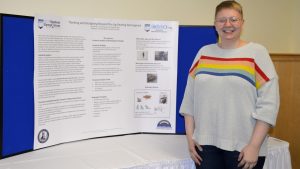Disability Studies’ Students Peer-Reviewed Poster Presentations at the 2023 University of Maine Student Symposium
Sabourin, C. (2023, April 14). Artificial intelligence in social work practice. (PDF). Peer-reviewed poster presentation at the 2023 University of Maine Student Symposium: Research and Creative Activity. Faculty mentor: Elizabeth DePoy. Abstract #710. Orono: Collins Center for the Arts.
710. Artificial Intelligence in Social Work Practice
Submission Type: Poster
Submission Category: Social Sciences & Humanities
Author(s): Cat Sabourin
Faculty Mentor: Elizabeth Depoy
Abstract: Social work is a diverse and evolving profession, which theoretically and in varied practice arenas, relies on what we refer to as the “being there” methods for promoting social change. (e.g. relationships, narrative therapy, and interactions). Although present in organizational contexts and potentially complementary to professional outcomes, education, intelligent tools have not been widely embraced to enhance and expand practice outcomes.
A growing literature has recognized the ubiquity of artificial intelligence and thus the critical need for social work to integrate these contemporary tools throughout the diversity of professional practice. Even with some reticence to adopt this technology, it is both necessary and opportune for professional survival and ability to continue essential work. Thus the field must stay current and collaborative in its knowledge, research, education, and practices.
Integrating disability studies, social work, and contemporary artificial intelligence methods, this paper investigates, illustrates, and evaluates a model of practice in which an intelligent AI robotic companion is used to further amplify and extend social work intervention for the purposes of 1. decreasing isolation and loneliness in adults residing alone in diverse rural to urban communities and 2. reducing institutionalization.
Methods
An extant data set from a statewide initiative in NY provides the data for analysis to evaluate the social, mental health, cognitive and eudemonic outcomes of incorporating AI into practice. Analysis will point to practice futures, research directions and educational implications for the field.
Watson, L. (2023, April 14). Thinking and designing beyond the jig – Seating reimagined. Peer-reviewed poster presentation at the 2023 University of Maine Student Symposium: Research and Creative Activity. Faculty mentor: Stephen Gilson. Abstract 711. Orono: Collins Center for the Arts.
711. Thinking and Designing Beyond the Jig – Seating Reimagined
Submission Type: Poster
Submission Category: Social Sciences & Humanities
Author(s): Lily Watson
Faculty Mentor: Stephen Gilson
Abstract: Most chairs aren’t designed to serve human bodies.
Sitting is a fundamental human activity, occurring for many purposes, within diverse contexts including but not limited to rest, conversation, eating, listening, consuming culture, learning, navigation, among many others. Curiously, contemporary seating in public spaces, adheres to standard chair design, “Seats are typically required to be between 16 to 20 inches (40.6 cm – 50.8 cm) tall and at least 18 inches (45.7 cm) deep. If backs are present on the seats, they typically are at least 14 inches (35.5 cm) high. If the seat has armrests, they should support the arms without raising the shoulders (Furniture Functions: Chairs|Seats).
Enter, the impaired body, not simply as source for treatment and revision but as a challenge to standard design and impetus for innovation and creative redesign. Combined with disjuncture theory, a contemporary approach to understanding disability as inability to complete a task, and the design adage of design for the extremes, this poster presents an innovative chair redesign project. The effort was intended to enhance comfort and functionality as well as aesthetics of seating in public spaces. The poster content synthesizes the scholarly rationale and redesign principles used to craft a design for flexible seating at a table, illustrates the redesign of chairs and tables. The work then proceeds to forensically analyze the redesign to highlight what yet needs to be done to advance seating design for the full diversity of seated bodies.
